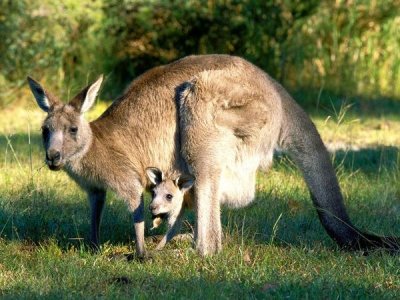Kangaroo Facts
 1. There are four main species of kangaroo with several subspecies that exist in the world today. The four main species are the Red Kangaroo, Western Grey Kangaroo, Eastern Grey Kangaroo, and the Antilopine Kangaroo.
1. There are four main species of kangaroo with several subspecies that exist in the world today. The four main species are the Red Kangaroo, Western Grey Kangaroo, Eastern Grey Kangaroo, and the Antilopine Kangaroo.
2. Kangaroos are mainly herbivores, meaning that they mostly eat plants, such as shrubs, tree leaves, grass and shoots.
3. The kangaroo’s diet provides them with most of the moisture they need. As a result, they can go several days without drinking any water.
4. Depending on their species, kangaroos can be between 3 and 8 feet tall. They can also weigh between 40 and 200 pounds when they are fully grown. The Red Kangaroo species is the largest of the four, but the Eastern Grey Kangaroo species is the heaviest.
5. Kangaroos use hopping as their primary means of traveling from one place to another. Male kangaroos can jump as high as 10 feet and they can cover a distance of 30 feet. They can also reach speeds as fast as 30 miles per hour while hopping.
6. A group of kangaroos is known as a mob, court, or troop. These groups can include as few as 10 kangaroos or as many as 100. Within the group, male kangaroos will box with each other in order to gain dominance.
7. Kangaroos will thump their feet on the ground very loudly when they want to alert others of an impending danger.
8. A baby kangaroo is called a “joey.” When they are first born, they can be shorter than one inch. Their size as a newborn can be compared to the size of a grain of rice to the size of a honeybee.
9. Following their birth, a newborn joey crawls into its mother’s pouch. For the next 120 to 400 days, it will nurse while it develops further.
10. The kangaroo is native to Australia. They are adaptable creatures so they can be found in a variety of places, including gardens, golf courses, and public parks.
11. Male kangaroos are often called jacks, boomers, or bucks. Female kangaroos are called jills, flyers, or does.
12. Female kangaroos can get pregnant again right after they give birth. She can hold both of the baby kangaroos in her pouch as they develop. She also produces two types of milk – one that is more suitable for the older joey and on that is more suitable for the younger joey.
13. Kangaroos cannot walk backwards because their tails are too bulky and their legs have unusual shapes.
14. Because of perpetual motion, kangaroos actually use less energy the faster they hop. That is until they reach a speed of 20 miles per hour.
15. The pouch on a female kangaroo’s body is called the marsupium.
16. When kangaroos are swimming, they can move both of their hind legs independently of each other. However, when they are on land, they can only move them together.
17. The gestation period for kangaroos is between 31 and 36 days. This would be the equivalent of the seventh week of pregnancy for humans.
18. Kangaroos raise three joeys about every two years on average.
19. Because a kangaroo’s legs are so strong and muscular, they are often used as weapons for defending themselves against predators.
20. Kangaroos only live to be about six years old in the wild.
21. The kangaroo is Australia’s official national symbol.
22. Only female kangaroos have pouches.
23. The kangaroo has a stomach much like cattle. It has two chambers. After eating, they regurgitate their food, chew it again, and then swallow it so it can be digested.
24. The only predators that the larger kangaroos have are humans, dingos, and crocodiles.
25. Although the process is not fully understood, it is believed that female kangaroos can determine the sex of her offspring.
